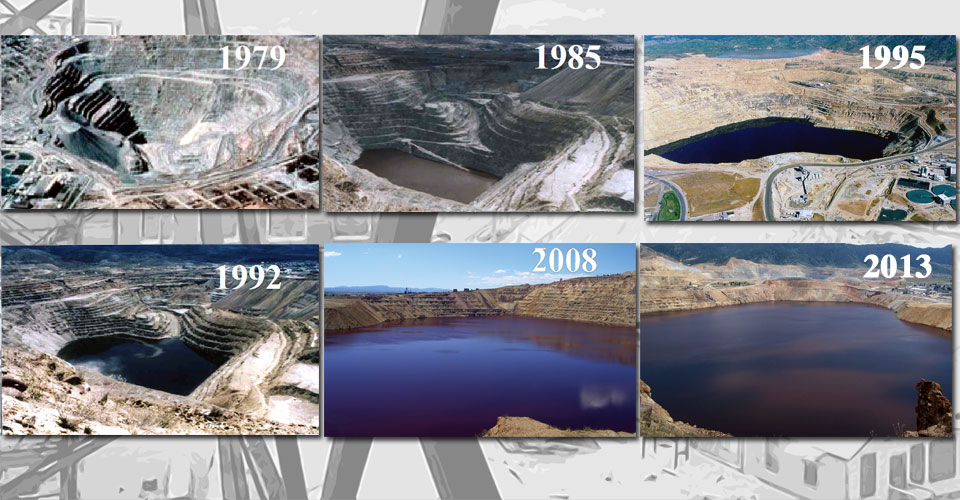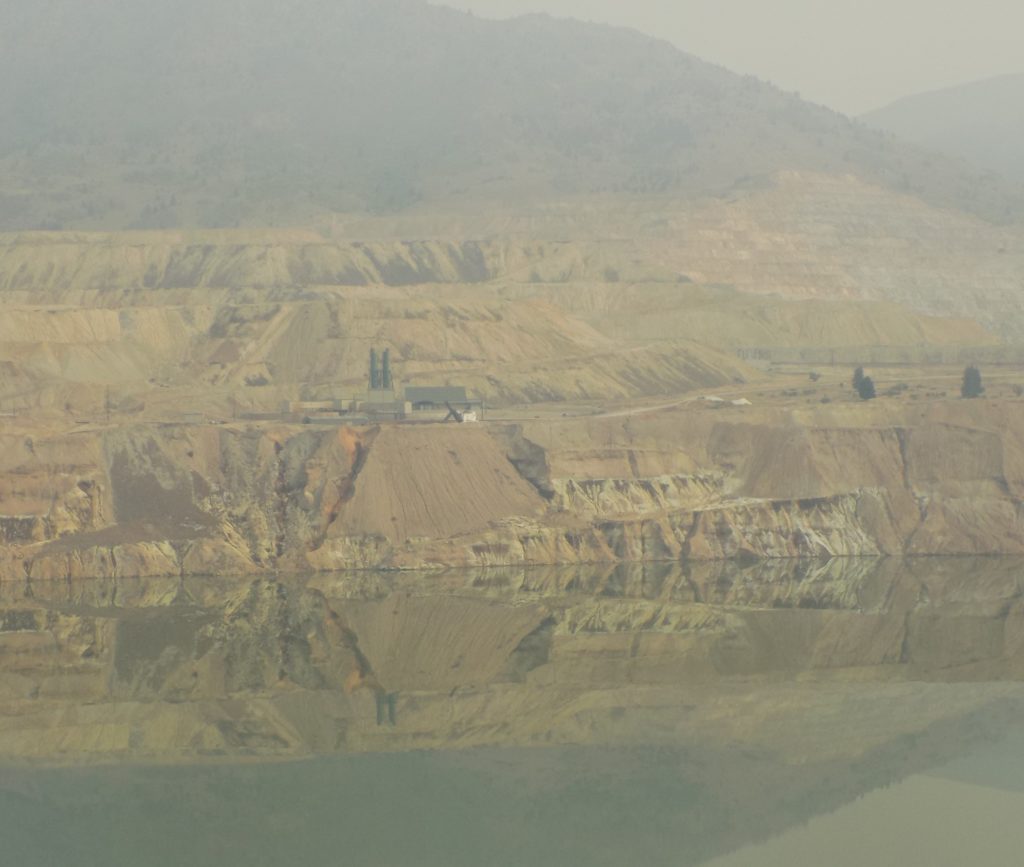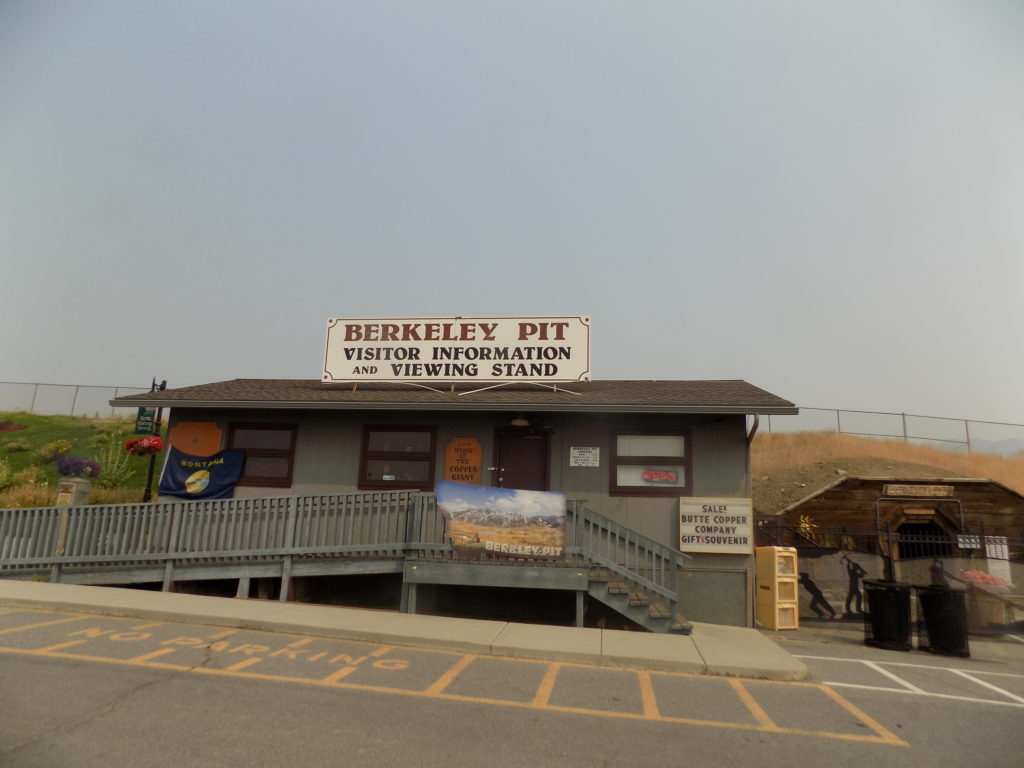Making toxic water.
As the pit grew, ACM began purchasing nearby properties until it had swallowed the surrounding neighborhoods of Meaderville, Dublin Gulch, and McQueen. In the sixties, the Berkeley Pit Mine was feeding the Weed Concentrator more than 50,000 tons of ore per day. (A concentrator separates different metals from within a block of ore. Different concentrators use different methods to achieve this goal.)
Flush with cash, Anaconda, now an international mining company, then made a sequence of bad investments. Two of its mines, the Chuquicamata mine in Chile and the Cananea mine in Mexico were nationalized in 1971 and in 1977, Atlantic Richfield (ARCO) purchased ACM shutting all underground mining and nearly all other operations including the mighty Washoe smelter – once the largest in the world. (Its smokestack still stands in the Anaconda Smelter Stack State Park.) ARCO continued mining at the Berkeley site until 1982. Copper prices had spiked in 1974 but declined steadily and in eight years the mine was no longer profitable.
As you might suspect, while pit mining is safer for the miners, mining of any sort is not the cleanest, most environmentally friendly way to produce usable resources. And the Berkeley operation was no different. Concurrent with the 1982 cessation of operations at the pit was the shutdown of the pumps in the nearby Kelley mine. This photo taken from the site pitwatch.org shows what has happened as groundwater from surrounding aquifers began filling the pit.
I’m not certain the tiny photos in this composite do justice to the size of the pit. It’s more than 7,000 feet long, 5,600 feet wide, and 1,780 feet deep (with the water filling about 1,000 feet of that depth). Its circumference is four miles. Here are a few of the problems the pit engenders:.
- The water flow with dissolved oxygen, allows pyrite and sulfide minerals in the ore and wall rocks to decay leaving the water not only heavily mineral laden but with a pH of 2.5 to 3.0 – about the same acidity as lemon juice.
- The acidic water in the pit carries a heavy load of dissolved heavy metals. More than 13 million gallons of water per day are pumped out as part of Montana Resources’ copper recovery project.
- In addition to copper, the pit contains high levels of arsenic, calcium, cobalt, potassium, magnesium, sodium, iron, manganese, aluminum, cadmium, and zinc as well as chloride, fluoride, and sulfates.
- In 1995, a flock of snow geese landed in the pit resulting in 342 bird deaths. In 2016, more than 1,000 geese were killed when they used the water.
The Environmental Protection Agency (EPA) assessment of the site and its impact on Silver Bow County states,
Ground water, surface water, and soils are contaminated with arsenic and other heavy metals, including copper, zinc, cadmium, and lead. Silver Bow Creek and the Clark Fork River contain metals from the cities of Butte to Milltown. The tailings, dispersed along the creek and river, severely limit aquatic life forms and have caused fish kills in the river. Potential health threats include direct contact with and ingestion of contaminated soil, surface water, ground water, or inhaling contaminated air.
The rising water level presents also an enormous challenge and a real and present danger. The most recent update on pitwatch.org at 29 June 2023 (updated during 2023 editing) showed a water level of 5,355.96 feet above sea level with the water rising between four and seven feet per year. At the pit, there’s a marker at 5,410 feet above sea level known as the “critical water level.” This is the point at which the poisons and toxic metals in the water can seep through the walls of the pit and into Butte’s aquifer. This would likely contaminate the water supply and make the city uninhabitable so water is continually pumped out.
What’s being done?
The city, state and federal governments have taken some steps in an effort to stave off that potential disaster. First, the city’s water today comes from a source on the other side of town. However, although officials reassure residents that this step and the fact that the Pit water hasn’t reached the critical level means the water is currently safe, some residents remain skeptical. (I couldn’t find any contemporary sources to indicate the effect of Flint, Michigan’s 2014 crisis on local attitudes about Butte’s water.)
Next, EPA classified the Berkeley Pit as a Superfund site nearly 24 years to the day prior to my visit. (I was there on 6 September 2017 and the listing was posted on 8 September 1983.) In its Record of Decision, it required that “surface water flowing into the Berkeley Pit be captured and either used in the mining process or treated.” To that end, Montana Resources constructed the Horseshoe Bend Water Treatment facility in 2003.
(You can spot the towers of the plant just left of center in this photo.)
At present, the plant is used to capture and treat surface water that would otherwise flow into the Pit. The treated water is then used in Montana Resources mining operations. The process used in the plant generates 90 percent less sludge than a conventional lime treatment plant and the remaining sludge from the treatment process is returned to the Pit. No water or waste leaves the Pit or mine site. But still the water rises.
Astonishingly, despite the toxicity of the water, at least two life forms call the Pit home. The first is a species of a relatively common aquatic insect called the water boatman. Perhaps more remarkable was the discovery in 2000 by a group from Montana Tech of several species of protozoa and algae that appear to digest iron and other metals in the water. Ongoing studies are examining the possibility of using these species as an alternative or supplemental means of cleaning the water.
Meanwhile, the Pit has become a Butte tourist attraction.
For a mere two dollar entrance fee payable in the information office, you can walk through a long tunnel (you can see the entrance at the right) onto the viewing stand and look out at what the genial woman working in the office called with a mixture of humor and pride, “the largest body of toxic water in the country.” She was also quite flexible about the entrance payment telling me and the handful of other visitors (it’s true, I wasn’t alone) that we could walk out to the platform and pay her when we returned. She also warned us not to worry if we heard what sounded like occasional cannon fire while we were on the viewing platform assuring us that we weren’t under attack but that different sounds would randomly blast across the Pit to discourage geese and other fowl from landing in the water.
After I’d finished my personal Pit watch and returned to the Visitor Center, I paid my fee and she and I had a pleasant chat back and forth about several topics as I wandered around looking for a souvenir or two. When I mentioned my preference to support locally owned businesses, she recommended a restaurant called Fred’s Mesquite Grill where I had lunch. I had a Caesar salad and the shrimp and vegetable kabobs, too much bread, and a Wakeboard witbier which had a thin head but was quite smooth.
The Auditor.
I have one final bit of Butte quirkiness to report before setting off for Missoula. It concerns Ralph – aka The Auditor. It seems to me that of the two main domestic pets in America, cats are ascendant especially in the era of You Tube videos but, as a species, I think we humans have a special connection with dogs.
Such was the case in 1986 when a visitor to the Berkeley Pit Viewing Stand abandoned a white puppy. The puppy was beyond skittish around people and evaded all attempts to rescue him. Over time, he found his way onto the mine site and the miners and clean-up workers adopted him in a way.
They built a dog house near the center of what they thought was his territory. Despite leaving food and water for him daily, the dog never approached the men or let them approach him. Some of the workers called him Ralph but most called him “The Auditor” because, according to a story in the Montana Standard, “…after disappearing for days, he always showed up when you least expected him.”
The Auditor died in his dog house on 19 November 2003 and if you’re interested, you can read more of his story here. So attached had the community and miners become to him in spite of his aloofness that they began raising funds for a memorial. Although there are plans to move it to the Pit viewing site, as of the day of my visit the 300 pound copper plated bronze sculpture was located in Butte’s Chamber, Visitor and Transportation Center.
In the next entry, I’ll tell you about an unusual sculpture in Missoula and treat you to some other unexpected places to visit in Montana.



